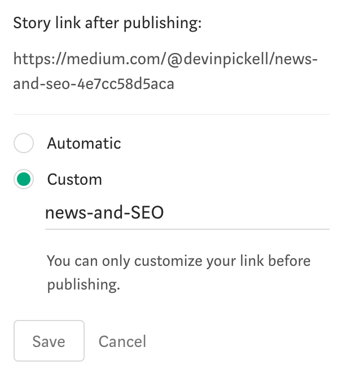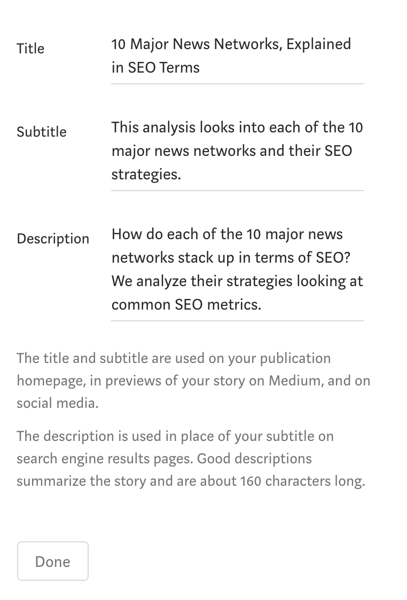
Publishing on Medium is easy. Getting real results on Medium? That’s harder.
Whether you're an independent creator trying to monetize thought leadership or a brand looking to expand top-of-funnel visibility, Medium offers one of the web’s most accessible and competitive platforms for long-form storytelling.
Its built-in audience, sleek UX, and domain authority make it a tempting publishing hub. But with thousands of new articles published daily, most posts are buried before they gain traction.
Write effectively on Medium by starting with a clear headline, using short paragraphs, and adding visuals to break up text. Focus on one key message per article, write in a conversational tone, and include a strong call to action. Optimize with tags and publish consistently to grow readership.
If you're new to the writing gig, AI writing tools can be a great way to improve your content structure, tone, and reach.
In this guide, we'll cover the essential tips and strategies for writing effective Medium articles. We'll discuss everything from topic selection to publishing. Let's dig in!
After signing up for Medium, customizing your profile, and including a few words about yourself, it’s time to start thinking about what you want to write.
Here are a few tips to consider:
Every article on Medium is tagged to its proper category, so this should help provide some inspiration on what to write. Some of the popular categories on Medium include:
Other popular topics to write about on Medium include money, culture, education, comics, photography, spirituality, fashion, music, humor, and others. As you can see, there are many diverse interests on the platform.
Medium isn’t exactly the spot to publish sales and marketing-heavy content. If you’re representing a business, focus on thought leadership, not lead gen. Include links where natural, but don’t structure your piece as a funnel. As a matter of fact, Medium itself says this is generally frowned upon in their writing community.
An actionable way to engage with your readers on Medium is to encourage them to ‘clap’ if they find your article valuable. Claps are considered in Medium’s ranking algorithm, and many claps can catapult your article in the eyes of more readers.
Your goal as a writer should never be to mislead readers into clickbait, and you should double down on this when it comes to Medium. Authenticity wins. Share real stories, show vulnerability, and offer original analysis rather than surface-level summaries. Medium’s audience doesn’t just want “takes”, they want substance.
That said, credibility still matters. Back up claims with links to studies, real numbers, or visual evidence when possible. If you're making health or financial claims, cite verifiable sources. Medium has become more proactive in flagging misinformation.
It is strongly encouraged to post original insights and perspectives. Medium states that aggregating content is frowned upon, and plagiarizing other people’s work can lead to a few consequences. If caught plagiarizing, the original author could issue a cease and desist, request a reference link, force a complete rewrite, or negotiate a royalty.
The easy way to avoid all of this is simply not plagiarizing. Instead, map out your thoughts and conduct meaningful research before you begin typing. To learn more, read our guide on the five most common types of plagiarism.
You don’t need a 3,000-word essay to make an impact on Medium. But you do need clarity, and structure is key. Start by keeping your paragraphs short. Two to four lines is the sweet spot, especially for mobile users who scroll fast and skim often.
Use subheadings (H2s and H3s) to break your article into digestible sections. This helps guide your reader through your ideas and signals structure to Medium’s algorithm.
Format intentionally. Bold key takeaways to create visual anchors. Use italics to emphasize nuance. When listing steps or ideas, bullets are your best friend.
And remember: a concise 800-word tutorial can outperform a lengthy 2,000-word thinkpiece if it’s well-focused and well-formatted.
Medium favors content that keeps readers engaged beyond the scroll. That means encouraging small actions at the end of your piece, without overdoing it.
A simple prompt like “Clap if this was helpful” invites feedback and boosts visibility. You can also ask a question, suggest they leave a comment, or offer a follow for more stories.
Want them to share the piece? Ask, but do it authentically. One genuine call to action is more effective than a list of asks. Ultimately, you're not just writing; you’re starting a conversation. Medium rewards that.
So, you have an idea of what to write and how to write it, but how do you get the most out of your content? How do you ensure people are seeing and reading your articles? Here’s what to check before you hit publish.
On-page writing elements refer to individual tweaks made to a piece of content to improve its searchability and user-friendliness. This is commonly done for SEO reasons, but Medium has on-page tweaks that can be made to increase visibility as well.
First off, you should already be using images in your Medium content since articles with images get more views than text-only articles. Next, be sure to include alternative text with these images. Alt-text makes images more accessible to sight-impaired users, hence, a greater audience. Be sure to describe the image so screen readers can accurately depict your image.
Most writers are aware of headers of different sizes and their readability, but did you know header tags are important for informing search engines of what your content is about? Using header tags properly in Medium is important.

The large T signifies an H1 tag and should contain some variation of your target keyword. The small T signifies an H2 tag and should complement your H1.
For example, if your H1 is “How to write a marketing email,” the H2 tags should be the individual steps of that process, i.e., “Write a captivating subject line” or “Be short and to the point.”
Medium allows content creators to customize their story links before publishing. This can be done by tapping the More options menu and selecting the Custom story link. Do so in a way that makes sense to the reader but also has SEO value.

Customize links in a way that makes sense to the reader but also has SEO value. If you have a keyword research tool or some SEO software, you can analyze which keywords have the highest volume and aim for one when customizing a URL.
Publishing software typically requires you to enter a meta description before going live, although Medium does not. Instead, you’ll need to tap the More options menu and select Change display title/subtitle to begin customizing.

A meta description is an HTML tag, typically 160 characters or less, that summarizes the content of your article. A good meta description is important for both readers (it increases click-throughs) and search engines (it increases ranking).
If you really want to reach a variety of readers, consider tagging your content with relevant topics. To do so, tap the More options menu and select Change tags.

Add topic tags that are both high-volume and relevant to your story. You can add up to five tags per article.
Medium may be a Web-publishing platform for amateur and professional writers, but users should still look to expand their networks. This is another less-referenced way to maximize your profile's visibility.
See a publication that interests you? Follow it and engage with its day-to-day writers.
Clap for stories you enjoy to uplift them, and share your thoughts in the comment section. Let the author hear your take on their story, and offer a new perspective if you feel it adds substance.
The more you engage on Medium, the greater the likelihood that other users become aware of your work.
Publishing on Medium isn’t a one-and-done process. If you want to grow, you need to know what’s working and what’s falling flat.
That’s where Medium’s built-in analytics come in.
After publishing, go to your Stats dashboard. There, you’ll find data on views, reads, claps, and fans. It’s not as robust as Google Analytics, but it gives you just enough to learn and iterate.
Let’s say you’re getting a lot of views but few reads. That usually means the title is strong, but the intro or formatting isn’t keeping people around. Revisit your hook. Make the first few lines tighter and more curiosity-driven.
If you’re seeing strong read ratios but low claps or comments, your article might be educational but not emotional. Try ending with a question or stronger CTA next time.
If an article outperforms others, dig into why. Was it the headline? The niche topic? The publication you posted in? Use that insight to replicate success, not just guess.
Find answers to some of the most common questions about writing on Medium to help you get started and make the most of your experience.
Yes, you can write on Medium for free. Anyone can create an account and start publishing articles on the platform. However, if you want to access some premium features or content, you may need to subscribe to Medium's membership program.
Yes, you can get paid for writing on Medium through the Medium Partner Program. Writers earn money based on the amount of time Medium members spend reading their content and through member-only stories. To join the program, you need to have at least 100 followers and meet some pre-defined eligibility criteria.
Yes, you can republish content on Medium, but it's important to note that it may affect SEO performance if it's duplicate content. To avoid this, you can use the canonical link feature on Medium, which credits the original source of the content.
Medium provides built-in analytics that allows you to track the number of views, reads, and claps your articles receive. You can access these insights through the "Stats" section of your Medium account.
To get more claps, you need to earn them through value and clarity. End your article with a direct call to action, such as “Clap if this helped” or “Let me know if this resonates.” Articles that are well-structured, emotionally resonant, or deeply practical tend to get the most claps.
If you're just starting out or experimenting, your personal profile is perfect. But if you’re building a brand, publishing frequently, or collaborating with others, creating a Medium publication gives you more control over branding, structure, and submission. It also helps organize your content under one branded hub.
Yes, you can update your Medium article at any time, even after it’s live. Simply click the “Edit story” option. Updated articles retain their URL and engagement stats, but frequent or major edits after publication may affect visibility if they confuse readers or change the topic. Try to get the core structure right before hitting publish, then refine as needed.
Building a readership isn't a linear process. The key is persistence, creativity, and understanding your audience. Focus on crafting compelling headlines, telling authentic stories, and optimizing your posts for discoverability. Remember to keep experimenting, learning, and refining your approach to stay ahead.
Looking to publish a physical copy of your work? Consider the benefits of desktop publishing software to get the job right.
This article was originally published in 2019. It has been updated with new information.
Devin is a former senior content specialist at G2. Prior to G2, he helped scale early-stage startups out of Chicago's booming tech scene. Outside of work, he enjoys watching his beloved Cubs, playing baseball, and gaming. (he/him/his)
Consumers’ attention spans are shorter than ever, so how do you get your business to stand out...
 by Emily Goorevich
by Emily Goorevich
The more data we collect about our marketing activities, the more doors can open to lead us to...
 by Daniella Alscher
by Daniella Alscher
Social media is essential for building your business online.
 by Yash Chawlani
by Yash Chawlani
Consumers’ attention spans are shorter than ever, so how do you get your business to stand out...
 by Emily Goorevich
by Emily Goorevich
The more data we collect about our marketing activities, the more doors can open to lead us to...
 by Daniella Alscher
by Daniella Alscher


